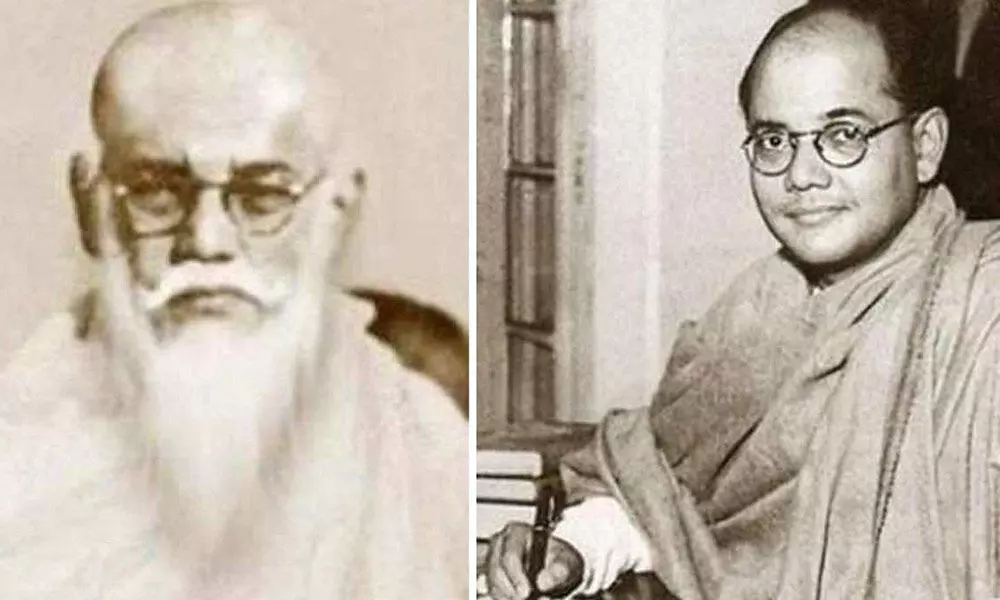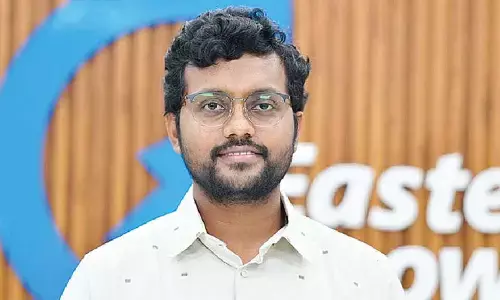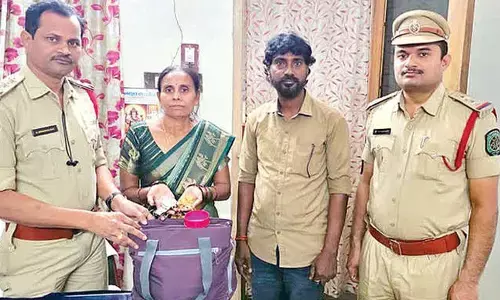Gumnani Baba is/not Subhas Bose'

Gumnani Baba is/not Subhas Bose'
The School of Law, Mahindra University, organised 'Authors Speak…' in last two weeks, celebrating 75 years of Indian Independence and 125th birth anniversary of Netaji, wherein committed researcher-authors of two books each on Netaji, Chandrachur Ghose (one of the founders of five member Mission Nethaji) and M V R Sastry, a senior journalist, explained their research on Netaji's life an death, agreeing on his national heroship, and giving conflicting conclusions on plane crash and identification of Gumnami Baba. Both the authors worked hard to study various documents and articulated their narration about the so called 'mystery'.
The School of Law, Mahindra University, organised 'Authors Speak…' in last two weeks, celebrating 75 years of Indian Independence and 125th birth anniversary of Netaji, wherein committed researcher-authors of two books each on Netaji, Chandrachur Ghose (one of the founders of five member Mission Nethaji) and M V R Sastry, a senior journalist, explained their research on Netaji's life an death, agreeing on his national heroship, and giving conflicting conclusions on plane crash and identification of Gumnami Baba. Both the authors worked hard to study various documents and articulated their narration about the so called 'mystery'.
Chandhrachur spoke on 'Mysteries and Untold Stories of Netaji Subhas Chandra Bose' saying that there was overwhelming evidence to say Gumnami Baba was Netaji himself. The second author MVR Sastry presented equally authentic and overwhelmingly logical reasons to conclude that Netaji was not Gumnami Baba and the plane crash killing Netaji was an established reality. Sastry investigated the Indian history and authored books on Indian Freedom Movement, Gandhi, Kashmir, and Netaji Subhas Chandra Bose.
Chandrachur's Contention
Chandrachur Ghose group probed into the disappearance of Bose. Witth his fellow researcher, Anuj Dhar, he penned a bestselling book, 'Conundrum: Subhas Bose's Life after Death' (2019), which was adapted into a film called" Gumnami" in the same year. Recently Penguin published his research based monograph, 'Bose: The Untold Story of an Inconvenient Nationalist' in February 2022 giving details of Netaji's early political life. His first book gave historical details with documents that formed part of declassified files.
Chandrachur and Anuj collected plenty of evidence, like independent opinions from national and international experts, and concluded that the official claims of the Indian government about the Taihuku (Taiwan) plane crash theory that killed Bose was disproved. Through his monograph, he revealed Netaji's unconventional style of politics, which belied all existing mainstream trends of Indian national politics. He opposed the incrementalism of the Gandhian Congress, the doctrinaire politics of the Communist Party, and communalism in politics and prioritised national interest over abstract political and moral theory in his demand for complete independence. This made Netaji 'inconvenient' to almost all the political groups in the country.
Most government files related to Netaji's mysterious disappearance were kept secret until three major rounds of declassification. First, it was the UPA government that declassified several files in 2010 and released over 10,000 pages related to the functioning of the Justice Mukherjee Commission of Inquiry. The second round took place when Bengal Chief Minister Mamata Banerjee declassified 64 files in 2015. Mission Netaji campaigned for the transparency, that fructified in two rounds of declassification.
They pursued the issue further by filing several RTI requests under the Right to Information Act 2005. Their meticulous scrutiny of those documents revealed that the Central and the Bengal governments were snooping on everyone associated with Bose until the 1970s; the resultant outcry led the Narendra Modi government to release 303 files on 23 January 2016.
According to Ghose, these files establish that Bose returned to India in the early 1950s and continued to live in anonymity till his death in 1985. He analysed that Justice Mukherjee Commission of Inquiry found credible evidence to support the claim that Bose returned to live in India, but hesitated to conclude the same because of a lack of clinching evidence. The two biggest obstacles were DNA reports and handwriting analysis reports from government laboratories that opined that samples from the unnamed saint, also known as Gumnami Baba, did not match Bose's. Ghose suspected that these reports were fudged.
Sastry contradicts
MVR Sastry contended that between 1945 and 1974 almost ten investigations took place which were conducted by the British Army, by the Allied Command based in Japan, the Government of British India, the Governments of Japan and Formosa, followed by three commissions appointed in India, and also by individual journalists and followers of Bose and all of them concluded that Netaji died on the fateful night of 18 August 1945, after third-degree burn injuries due to air crash.
Sastry reasoned it out saying the heroic and adventurous character of Netaji is not compatible with a silent and inactive or docile living, tolerating the politics of Congress Prime Ministers until his ignominious death in 1985. Its unimaginable for the hero to do so. His unfortunate death in a crash was proved beyond reasonable doubt, said Sastry.
Chandrachur Ghose says though there is enough circumstantial evidence to prove that Netaji and the unseen holy man Gumnami Baba were the same person, the political groups are not interested in bringing out the truth.
While noting that almost 77 years have passed since the plane crash, Sastry called for a coordinated campaign to create pressure on the present government, bring back the ashes from the Renkoji temple in Japan, and conduct a DNA test.
He highlighted the exemplary leadership and uncompromising political approach of Bose. The speaker raised a brainstorming question: did India gain independence due to the supreme sacrifices made by Netaji Bose with the strength of Indian National Army or by non-violent Satyagraha movement? MVR Sastry's well-researched narrative about Bose's determined character created an urge among the audience at the School of Law to explore further details about the incredible contributions of the forgotten hero.
Dr Paromita Das Gupta, a history faculty at the School of Law, questioned the authenticity of the plane crash theory saying no inquiry commission had ever visited the crash site and collected data from ground zero, and missing passengers list, which were also relied by the Ghose group. She referred to Netaji's co-passenger and his closest aide Habibur Rahman, and alleged him to have planted the crash theory. She said he had no scratch on his body despite a shocking plane crash that caused third-degree burns to Netaji.
Sastry answered that there was enough circumstantial evidence to prove plane crash theory and bring closure to this long-running disappearance saga of a leader who delivered his promise: a Free India through strategies that appeared to be unacceptable to his contemporaries, but that captured the essence of our great national leader. Sastry highlighted the need to give this tallest freedom fighter his long-overdue place of honour in history of freedom struggle after 75 years of India's independence.
Both the authors vehemently argued that it was Netaji's valour and fight through INA that scared the British government and compelled them to get out of India, and not because of exhausted leadership of Congress led Indian Independence Movement. I remember as the Central Information Commissioner that the government refused to answer one RTI request to know the official status of soldiers of Indian National Army under Netaji, whether the government recognises INA soldiers as freedom fighters or traiters.
(The author is Dean & Professor, School of Law, Mahindra University, Hyderabad, and former Central Information Commissioner) (The opinions expressed in this column are those of the writer. The facts and opinions expressed here do not reflect the views of The Hans India)

















